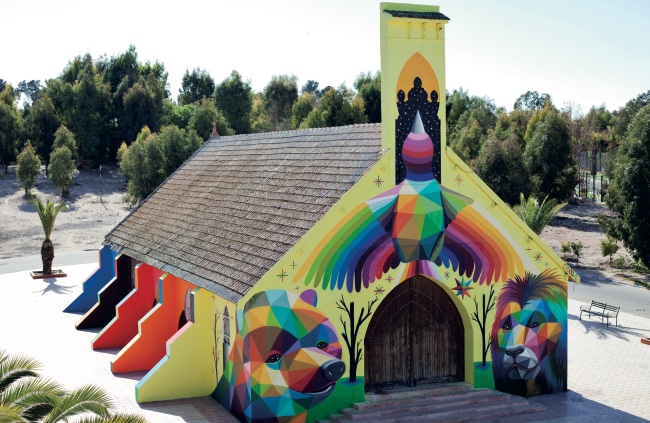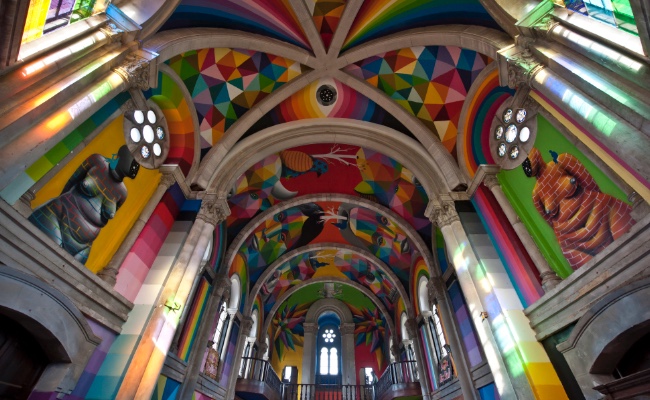
In some ways, cities feel like living beings. They’re born, grow, develop cool counterculture that some worry is ruining the country, become successful, and then, eventually, get old. Parts become irrelevant and decay. Sometimes entire pieces just…die. In the end, you’re left with empty buildings and neighborhoods that were once bustling hubs of activity, work, and pleasure. Alone and abandoned.
This even happens in bits and pieces in the most populated metropolises on earth. In booming cities in which every square foot is claimed and coveted, massive buildings decay. It’s a shame, really. But from death comes rebirth and sometimes old structures find new life and new purpose in a world that’s turned its back on them.
We love witnessing the creative repurposing of such abandoned city spaces — factories that become cool lofts and offices, hotels that spring up out of old warehouses, and parks built atop old subway tracks. These reuses support the community and revive the decaying parts of a changing city, making it feel alive and whole again. By recycling materials, restoring historic details, and even wildly reimagining what a certain space could be, derelict buildings are allowed to live a second, purposeful life and, in turn, revitalize entire neighborhoods.
These are some of the coolest projects worldwide to feature reimagined abandoned spaces.
From A Church To A Skate Park — Kaos Temple, Llanera, Spain

One of our favorite repurposed projects was by street artist Okuda San Miguel. Basically, San Miguel became obsessed with an abandoned Spanish church, built in 1912, and adopted it as his passion project.
“I fell in love with it,” he told us. “I decided to talk with the owners. They knew my work, and they told me that I could do whatever I wanted.”
The project became Kaos Temple, a church turned into a skate park with San Miguel having painted every surface in bold color. The result: the run-down building is now brimming over with life and youthful energy. The church became a mecca for skaters, and also, launched the artist to worldwide fame.
From A Firehouse To A Chic Hotel — Foundation Hotel, Detroit, United States
Voted one of the 100 “World’s Greatest Places 2018” by Time Magazine, the Foundation Hotel is incredibly cool. A refurbished firehouse from the 1920s, Foundation was reimagined as a sleek, gorgeous space with 100 rooms and two renowned restaurants. It’s filled with thoughtful touches meant to keep the spirit of the original, like refinishing the firehouse doors, keeping large windows that let in tons of light, and incorporating newspaper clippings from its heyday on the wall.
The accolades for Foundation just keep coming. Chef’s Table, the smaller more intimate restaurant helmed by Chef Thomas Lents was named the Restaurant of the Year by Detroit Free Press and his other, larger offering in the hotel, The Apparatus Room, was named the Hottest Restaurant of the Year by Eater Detroit.
It’s an absolutely dreamy and well thought out repurposing that is breathing life back into a vibrant city.
From A Nuclear Power Plant To A Theme Park — Wunderland Kalkar, Kalkar Germany
One of the weirder (or shall we say, more creative) repurposings was of a Nuclear Power plant in Germany to a children’s theme park. Okay, well, not actually. Kalkar power plant was built but never put into service. Construction, which started in 1972 was done in 1985. Then, Chernobyl happened and the people of the area were not so keen on a new nuclear power plant being put in their backyards. Years passed, then finally, it was sold to a Dutch investor who thought, “Hey, why not put some rides in?”
The venture has, surprisingly, been super successful. The park gets six-hundred-thousand visitors a year. And if you’re into really getting into the vibe. The swing ride operates within the original nuclear cooling tower. Add in a spider to bite you, and you’re well on your way to becoming a superhero.
From A Machine Works Factory To A Brewery And Restaurant — Southern Pacific Brewing, San Francisco, United States
https://www.instagram.com/p/BsglrgTBjeo/
This factory turned brewery is just so beautifully done. Once the C.A. Kilger Machine Works, built in the early 1900s, the ten-thousand-square-foot warehouse stopped being useful and fell into disuse. Luckily, it’s been thoughtfully redone into a brewpub, restaurant, and bar.
So many of the details are intact from the large factory windows to the gorgeous skylights to the salvaged wood. Trees grow in the middle of the space, giving it just a touch of that “urban space reclaimed by nature” vibe, but otherwise, it’s entirely chic and modern feeling.
From Subway Tunnels To An Underground Skate Park And Arts Space — House of Vans, London, England
https://www.instagram.com/p/Btwm_A_lA_p/
This space is just sooooo cool. The subway tunnels maintain their feel of urban underground transportation (I mean, how could they not) while being transformed into a maze of concert spaces, art studios, and a series of narrow skating venues. London’s only indoor skate park, House of Vans’ history, artwork, and repurposing as a living tribute to all aspects of skate culture all make this an incredibly innovative and fun space in the city.
From A Sugar Refinery To A Rock Climbing Facility — Allez UP Rock Climbing Gym, Montreal, Canada
https://www.instagram.com/p/BtyrGRXBsCj/
Allez UP took the silos from a Redpath Sugar Refinery and turned them into a beautiful, modern climbing gym with stark white walls as a nod to their former, sugary resident.
Located in Montreal’s Southwest borough, the gym is a sign of revitalization, maintaining a quirky vibe while providing a super cool activity for the neighborhood. Filled with natural light and large, factory-style windows, it’s the kind of gym that never feels dank or gross. That makes it a beautiful way to spend an afternoon in this historic space.
From Empty Lots To An Artistic Landmark — Magic Garden, Philadelphia, United States
https://www.instagram.com/p/BoZNWBpFw0O/
Now an urban art installation and park, Artist Isiah Zagar transformed a series of empty lots into a swirling mixed media maze of mosaics using a plethora of found materials. It’s a beautiful visual feat of design.
Originally starting as a small thing that grew, Zagar started doing small beautification art projects and installations. But as the years went on, whole walls were formed of his work, creating intricate paths in these vacant spaces. Eventually, the owner of the empty lots found out and demanded the art be taken down. But the neighborhood rallied around the odd, yet lovely creations, and formed a nonprofit organization to support and protect the artwork.
Now, the Magic Gardens, Zagar’s work has only grown, now including indoor galleries. Plus space used by all sorts of artists, classes, workshops, and weddings.
From A Coal Mine To An Ice Skating Rink — Zollverein Coal Mine Industrial Complex, Essen, Germany
https://www.instagram.com/p/BsSfTqKgTn7/
On the UNESCO world heritage list, Zollverein Coal Mine is an example, they say, of the evolution and decline of an essential industry of the past 150 years. A bustling site in the 19th and 20th centuries, it went into decline as jobs became scarce.
Now it’s been repurposed into a series of museums, a restaurant, and a gigantic ice skating rink, with many parts preserved of the old mine so visitors can see a bit of the history behind it. It’s a multi-use center that highlights rather than hides its roots.
From An Olympic Aquatic Center To A Waterpark — Water Cube, Beijing, China
https://www.instagram.com/p/9k-R7Tk1O0/
When the Olympics come through, countries rush to make spectacular facilities to herald the event. Afterward, though, there’s the problem of how to repurpose the spaces to keep them in continual use.
In Beijing, they’ve accomplished this with the Water Cube. Once the Olympic Aquatic Center, it still has the main pool to swim in, but it also has become home to China’s largest indoor water park. And it is absolutely insanely whimsical. With tons of rides, a theater, and bright colors, it’s a super fun repurposing of a space that otherwise wouldn’t have been frequented much post-Olympics.
From A Slaughter House To A Cooking School — The Professional Cooking School, Cadiz, Spain
It’s kind of fitting that this ancient slaughterhouse, filled with Phoenician columns in Spain’s Medina-Sidonia, was turned into a cooking school. It’s a modern version of something humans have always done, prepared food and then, eaten it.
Used for a while as the town garbage dump, this gorgeous building was reimagined and designed as a modern space with kitchens, a restaurant and bar, and spaces for chefs to study and learn. It’s beautifully thought out, feeling both new and state of the art, while also retaining the ancient bones and charm.






